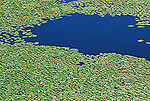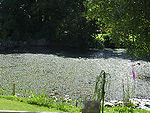Pondweed
| Pondweed |
|---|

|
| Scientific Classification |
|
| Species |
|
Pondweed is the common name for the species of aquatic plants that are assigned to the taxonomic genus Potamogeton. It is commonly found in ponds throughout the world. Their leaves grow in great bunches and often take up most of the pond providing shelter for organisms such as the mayfly larvae, Caddisfly larvae and even tadpoles.
Anatomy
Pondweed is often greenish in color and it grows submerged in shallow pond water. Pondweed has Elliptical leaves which float and Lanceolate leaves that are submerged in water. Pondweed leaves are pretty small in size, a few inches in length, and are often blade or oval shaped. The size of certain pondweed is beneficial for any wildlife in that are. The stem of pondweed is often long and thin, the leaves that grow are often somewhat small in size and grow in bunches. The submerged leaves of pondweed are very light in color and grow in bunches. Pondweed can produce fruit which grow on spikes slightly above the surface of the water and are red or brown in color. The fruit that pondweed produces is similar to a nut and is fairly small in size, being about 1/4 inch in length. The amount of pondweed present in an are can be affected by any chemicals that are in the water or people removing them.
Reproduction
Pondweed is a monocot that reproduces by the formation of seeds and asexual reproduction as well. The sexual reproduction of pondweed takes place in the early weeks of summer by forming a spike of perfectly made flowers on its stalk. The flowers of the pondweed then release their pollen, which rises to the surface of the water and floats, causing fertilization to then take place. Seeds that are still in development remain on the spike of the pondweed and aren't released until the season of fall. The rate of germination in the pondweed is quite low, which ends up making the asexual form of reproduction a lot more significant. The asexual form of reproduction in pondweed takes place through two different kinds of starchy tubers which both grow in pairs or singularly, and could end up forming plants sometime later in the spring season.
Ecology
Pondweed grows in shallow water in ponds and other small bodies of water. The roots of the pondweed are at the bottom of the water and the leaves just barely touch the surface of the water. Pondweed exists in several different countries such as America, Canada, and even Greenland. Pondweed grows in all 50 of the United States and most of Canada. Anywhere a pond is there is bound to be pondweed unless it has been removed. Pondweed does not require any special type of climate and grows well so long as there is enough water in the pond. In America, various types of pondweed can be found depending on where you are. Some different species of ponweed you can find here in America are: American pondweed, Illinois pondweed, baby pondweed, and Sago ponweed. Although unpleasant to look at, pondweed can be helpful for wildlife such as tadpoles.
Controlling pondweed
There are various types of ways in which one can remove pondweed, most aren't that difficult to do. Raking or seining pondweed from a pond will remove it but any remaining roots or fragments could cause the pondweed to come back. Colorants or dies that are non-toxic will reduce or may even prevent the plant growth by limiting the plant's penetration of sunlight. If Grass carp is put into the area where pondweed is, it will decrease the amount of pondweed slowly over time. Chemicals such as Redwing, Whitecap, and Symmetry are all good in the removal of pondweed but they can be harmful to other plants near the pondweed.




